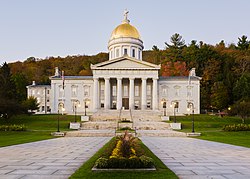- ▌ Robin Scheu (D, Add.-1)
- ▌ Amy Sheldon (D, Add.-1)
- ▌ Peter Conlon (D, Add.-2)
- ▌ Diane Lanpher (D, Add.-3)
- ▌ Matt Birong (D, Add.-3)
- ▌Vacant (Add.-4)
- ▌ Caleb Elder (D, Add.-4)
- ▌ Jubilee McGill (D, Add.-5)
- ▌ Joseph Andriano (D, Add.-Rut.)
- ▌ Nelson Brownell (D, Benn.-1)
- ▌ Timothy Corcoran II (D, Benn.-2)
- ▌ Dane Whitman (D, Benn.-2)
- ▌ David Durfee (D, Benn.-3)
- ▌ Seth Bongartz (D, Benn.-4)
- ▌ Kathleen James (D, Benn.-4)
- ▌ Mary A. Morrissey (R, Benn.-5)
- ▌ Jim Carroll (D, Benn.-5)
- ▌ Mike Rice (D, Benn.-Rut.)
- ▌ Bobby Farlice-Rubio (D, Cal.-1)
- ▌ Chip Troiano (D, Cal.-2)
- ▌ Dennis LaBounty (D, Cal.-3)
- ▌ Beth Quimby (R, Cal.-3)
- ▌ Scott Beck (R, Cal.-Ess.)
- ▌ Scott Campbell (D, Cal.-Ess.)
- ▌ Henry Pearl (D, Cal.-Wash.)
- ▌ Jana Brown (D, Chit.-1)
- ▌ Angela Arsenault (D, Chit.-2)
- ▌ Erin Brady (D, Chit.-2)
- ▌ Trevor Squirrell (D, Chit.-3)
- ▌ Edye Graning (D, Chit.-3)
- ▌ Phil Pouech (D, Chit.-4)
- ▌ Chea Waters Evans (D, Chit.-5)
- ▌ Kate Lalley (D, Chit.-6)
- ▌ Jessica Brumsted (D, Chit.-7)
- ▌ Noah Hyman (D, Chit.-8)
- ▌ Emilie Krasnow (D, Chit.-9)
- ▌ Kate Nugent (D, Chit.-10)
- ▌ Brian Minier (D, Chit.-11)
- ▌ Martin LaLonde (D, Chit.-12)
- ▌ Tiffany Bluemle (D, Chit.-13)
- ▌ Gabrielle Stebbins (D, Chit.-13)
- ▌ Barbara Rachelson (D, Chit.-14)
- ▌ Mary-Katherine Stone (D/P, Chit.-14)
- ▌ Brian Cina (P/D, Chit.-15)
- ▌ Troy Headrick (P/D, Chit.-15)
- ▌ Jill Krowinski (D, Chit.-16)
- ▌ Kate Logan (P/D, Chit.-16)
- ▌ Abbey Duke (D, Chit.-17)
- ▌ Carol Ode (D, Chit.-18)
- ▌ Robert Hooper (D, Chit.-18)
- ▌ Sarita Austin (D, Chit.-19)
- ▌ Patrick Brennan (R, Chit.-19)
- ▌ Seth Chase (D, Chit.-20)
- ▌ Curt Taylor (D, Chit.-20)
- ▌ Daisy Berbeco (D, Chit.-21)
- ▌ Taylor Small (P/D, Chit.-21)
- ▌ Karen Dolan (D, Chit.-22)
- ▌ Lori Houghton (D, Chit.-22)
- ▌ Leonora Dodge (D, Chit.-23)
- ▌ Rey Garofano (D, Chit.-23)
- ▌ Alyssa Black (D, Chit.-24)
- ▌ Julia Andrews (D, Chit.-25)
- ▌ Chris Taylor (R, Chit.-Frank.)
- ▌ Chris Mattos (R, Chit.-Frank.)
- ▌ Terri Lynn Williams (R, Ess.-Cal.)
- ▌ Larry Labor (R, Ess.-Orl.)
- ▌ Ashley Bartley (R, Frank.-1)
- ▌ Carolyn Whitney Branagan (R, Frank.-1)
- ▌ Eileen Dickinson (R, Frank.-2)
- ▌ Mike McCarthy (D, Frank.-3)
- ▌ Matthew Walker (R, Frank.-4)
- ▌ Thomas Oliver (R/D, Frank.-4)
- ▌ Wayne Laroche (R, Frank.-5)
- ▌ Lisa Hango (R, Frank.-5)
- ▌ James Gregoire (R, Frank.-6)
- ▌ Penny Demar (R, Frank.-7)
- ▌ Casey Toof (R, Frank.-8)
- ▌ Josie Leavitt (D, G.I.-Chit.)
- ▌ Michael Morgan (R, G.I.-Chit.)
- ▌ Jed Lipsky (I, Lam.-1)
- ▌ Melanie Carpenter (D, Lam.-2)
- ▌ Daniel Noyes (D, Lam.-2)
- ▌ Lucy Boyden (D, Lam.-3)
- ▌ Avram Patt (D, Lam.-Wash.)
- ▌ Saudia LaMont (D, Lam.-Wash.)
- ▌ Carl Demrow (D, Oran.-1)
- ▌ Monique Priestley (D, Oran.-2)
- ▌ Rodney Graham (R, Oran.-3)
- ▌ Joseph Parsons (R, Oran.-Cal.)
- ▌ Jay Hooper (D, Oran.-Wash.-Add.)
- ▌ Larry Satcowitz (D, Oran.-Wash.-Add.)
- ▌ Brian Smith (R, Orl.-1)
- ▌ Woodman Page (R, Orl.-2)
- ▌ Dave Templeman (D, Orl.-3)
- ▌ Katherine Sims (D, Orl.-4)
- ▌ Mark Higley (R, Orl.-Lam.)
- ▌ Michael Marcotte (R, Orl.-Lam.)
- ▌ Robin Chesnut-Tangerman (D, Rut.-Benn.)
- ▌ Patricia McCoy (R, Rut.-1)
- ▌ Tom Burditt (R, Rut.-2)
- ▌ Arthur Peterson (R, Rut.-2)
- ▌ Jarrod Sammis (L, Rut.-3)
- ▌ Paul Clifford (R, Rut.-4)
- ▌ Eric Maguire (R, Rut.-5)
- ▌ Mary Howard (D, Rut.-6)
- ▌ William Notte (D, Rut.-7)
- ▌ Butch Shaw (R, Rut.-8)
- ▌ Stephanie Jerome (D, Rut.-9)
- ▌ Bill Canfield (R, Rut.-10)
- ▌ Jim Harrison (R, Rut.-11)
- ▌ Logan Nicoll (D, Rut.-Winds.)
- ▌ Anne Donahue (R, Wash.-1)
- ▌ Kenneth Goslant (R, Wash.-1)
- ▌ Dara Torre (D, Wash.-2)
- ▌ Kari Dolan (D, Wash.-2)
- ▌ Peter Anthony (D, Wash.-3)
- ▌ Jonathan Williams (D, Wash.-3)
- ▌ Conor Casey (D, Wash.-4)
- ▌ Kate McCann (D, Wash.-4)
- ▌ Ela Chapin (D, Wash.-5)
- ▌ Marc Mihaly (D, Wash.-6)
- ▌ Tom Stevens (D, Wash.-Chit.)
- ▌ Theresa Wood (D, Wash.-Chit.)
- ▌ Gina Galfetti (R, Wash.-Oran.)
- ▌ Francis McFaun (R, Wash.-Oran.)
- ▌ Sara Coffey (D, Windh.-1)
- ▌ Laura Sibilia (I, Windh.-2)
- ▌ Michelle Bos-Lun (D, Windh.-3)
- ▌ Leslie Goldman (D, Windh.-3)
- ▌ Mike Mrowicki (D, Windh.-4)
- ▌ Emily Long (D, Windh.-5)
- ▌ Tristan Roberts (D, Windh.-6)
- ▌ Emilie Kornheiser (D, Windh.-7)
- ▌ Mollie Burke (D, Windh.-8)
- ▌ Tristan Toleno (D, Windh.-9)
- ▌Vacant (Windh.-Benn.-Winds.)
- ▌ John Bartholomew (D, Winds.-1)
- ▌ Elizabeth Burrows (D/P, Winds.-1)
- ▌ John Arrison (D, Winds.-2)
- ▌ Alice Emmons (D, Winds.-3)
- ▌ Kristi Morris (D, Winds.-3)
- ▌ Heather Surprenant (D, Winds.-4)
- ▌ Tesha Buss (D, Winds.-5)
- ▌ Kevin Christie (D, Winds.-6)
- ▌ Esme Cole (D, Winds.-6)
- ▌ John O'Brien (D, Winds.-Oran.-1)
- ▌ Rebecca Holcombe (D, Winds.-Oran.-2)
- ▌ Jim Masland (D, Winds.-Oran.-2)
- ▌ Kirk White (D, Winds.-Add.)
- ▌ Heather Chase (D, Winds.-Wind.)
|



